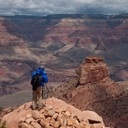0 Likes
Ilot Kouare is a protected sanctuary in New Caledonia's World Heritage Site Lagoon. It's about 40 nautical miles SE of Noumea, way down in the Great Southern Lagoon. The water is generally nice and clear surrounding Kouare and the reefs are really spectacular with some of the very biggest coral heads I've seen anywhere. The anchorage at Kouare is good with excellent holding and in theory you can anchor on any side of the island and find protection from most winds. But in practice whenever we go there the winds have a habit of blowing anywhere but where the weather forecasters have predicted.
The forecasters predicted light south to south west winds with partly cloudy skies for several days - starting on my birthday, so we sailed down and anchored in very calm and clear water within 80 metres of the best reefs off the northeast end of the island. I wanted to capture an underwater scenic sphere image that shows the wonderful diversity of corals. I used my Hero3 black edition mounted on an aluminium bracket and screwed onto the end of a 3 metre long telescoping carbon-fibre pole. I floated on the surface and lowered the camera down to just above a small coral patch between the edge of the fringing reef and a collection of big yellow Porites coral heads. With the camera set to click once every half second I slowly rotated the pole to capture the area. I used a lead sinker on a line as a plumb-bob to keep the pole vertical as I rotated it.
I had already done some experiments with the underwater angle of view of the GoPro. The image is sharp in the centre but there is vignetting and chromatic aberration on the edge of the image. So although the camera has an underwater horizontal field of view of 115 degrees in practice the angle between successive images needs to be no more than 60 degrees to be sure of having sharp coverage of the whole field of view. An angle of 45 degrees between images is better. Since I shoot with the camera in a portrait position that means I need two rows with the camera looking down 45 degrees from the horizontal and up 45 degrees from the horizontal plus one up shot and one down shot.
It takes between 8 and 10 images per row to get a reasonable stitch of the 360 degree field of view (with an overlap of no more than 45 degrees between successive images). So the final image will be a stitch of at least 18 images. In practice, however, I stitched this sphere from 33 images using AutoPano Giga version 2.5. First I processed the images for color and contrast then I simply drug them all at once into Autopano Giga and clicked on "detect." It made the stitch without a hitch, needing only an adjustment on where the center of the image should be.
The plan was to do another image first thing in the morning when it was supposed to be nearly calm with light SW winds. But when I woke up at dawn the wind was from the NE, not the SW and very cloudy with continuous lightning and thunder not far to the south. Over breakfast we contemplated moving around to the other side of the island, the radio forecast was still for SW winds even though we had NE winds. Then, just as we were getting ready to go it started blowing 30, then 40 with gusts to 50 knots from the SW with mighty bolts of lightning and deafining thunder. The sky was 100% cloud and heavy rain. So after the squall died down we upped anchor and retreated to a more secure anchorage. We'll be back.
...





New Caledonia is the closest South Pacific Island to Australia and New Zealand. It is a French Territory and although the official language is French the culture is a blend of Melanesian, European, Polynesian, Vietnamese, Chinese, Indonesian, and more. There is one large mountainous island called Grande Terre and 6 smaller islands - the three Loyalty Islands, Belep and the Isle of Pines.The islands are remarkably unpopulated and there are vast areas of wilderness. There are hundreds of kilometers of walking treks, camp grounds, more than 42 parks and reserves, and crystal clear rivers with sparkling waterfalls. Almost one third of the population is located in the capital city of Noumea. Nickel mining is the primary industry and is the major contributor to the high standard of living in the country. Grande Terre is surrounded by the second largest barrier reef in the world and the protected lagoon created by this barrier reef is the largest in the world. Listed as a World Heritage Site in 2008, the lagoon is 24,000 square kilometers and supports a diverse and luxuriant fauna of fish and invertebrates.The vibrant, clear and rich colors are one of the first things that visitors notice when they arrive. Noumea has a complete range of hotels, resorts, restaurants, and activities to welcome visitors.